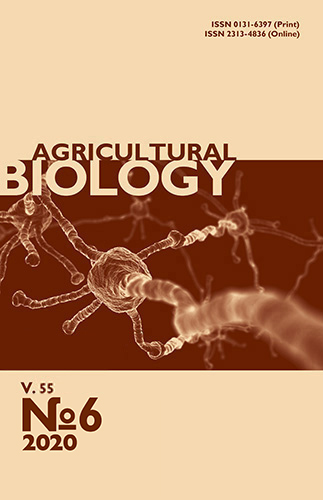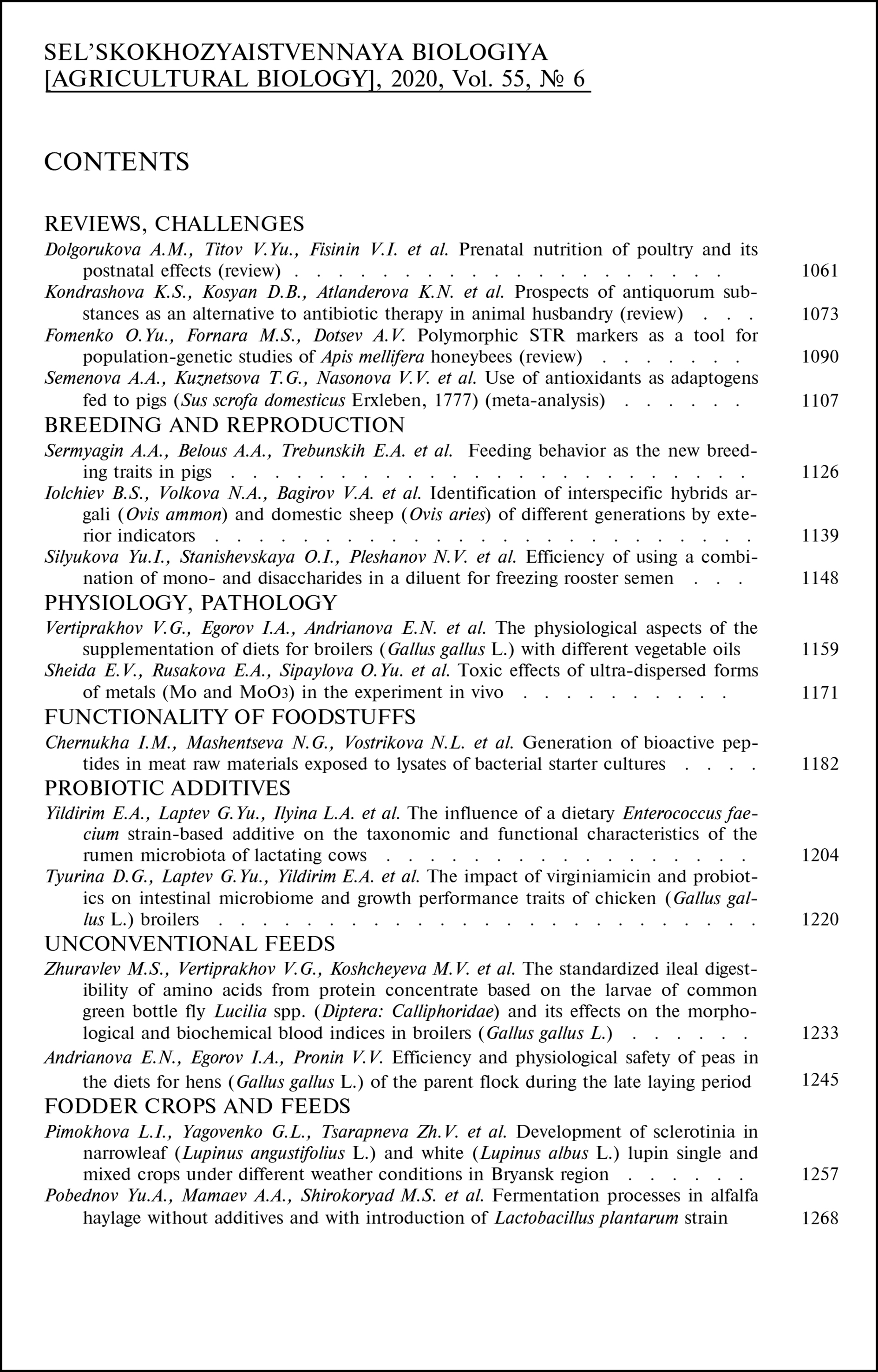doi: 10.15389/agrobiology.2020.6.1126eng
UDC: 636.4:636.082.2:612.311
Acknowledgements:
Supported financially from Russian Science Foundation, project No. 19-16-00068
FEEDING BEHAVIOR AS THE NEW BREEDING TRAITS IN PIGS
A.A. Sermyagin ✉, A.A. Belous, E.A. Trebunskih, N.A. Zinovieva
Ernst Federal Science Center for Animal Husbandry, 60, pos. Dubrovitsy, Podolsk District, Moscow Province, 142132 Russia, e-mail alex_sermyagin85@mail.ru (✉ corresponding author), belousa663@gmail.com, terramio7@mail.ru, n_zinovieva@mail.ru
ORCID:
Sermyagin A.A. orcid.org/0000-0002-1799-6014
Trebunskih E.A. orcid.org/0000-0002-5208-3376
Belous A.A. orcid.org/0000-0001-7533-4281
Zinovieva N.A. orcid.org/0000-0003-4017-6863
Received September 1, 2020
Pig breeding for improvements of growth and carcass traits, reproductive qualities as the main breeding criteria has been implemented in breeding practice for a long time. However, the used productivity traits do not involve a number of important economic indicators, in particular feed efficiency and behavioral characteristics of animals. The selection response for such traits is expected to give an additional increase in the accuracy of the breeding value of young animals when used at large nucleus farms. Undoubtedly, the transition to mass testing of animals at automatic feeding stations is currently the most accurate method for evaluating feed conversion rate and related traits of feeding behavior. This work aimed to study the genetic features of feeding behavior and growth traits of Duroc boars in relation to the residual feed intake (RFI) for use in the breeding process. The studies were carried out at Nucleus Farm TopGene for a population of 800 animals. Individual records for feed intake were collected using automatic feeding stations. Additionally, parameters of feeding behavior, average daily gain (ADG), and feed conversion rate (FCR) were recorded. To eliminate the influence of growing factors on the studied traits, a regression analysis was performed to correct feed conversion rate, as well as the calculation of genetic and paratypical variances. The RFI values were obtained based on the difference between the actual and predicted average daily feed intake, considering the average metabolic weight, and the body weight gain of animals according to the multiple linear regression equation. The average values and heritability of the main breeding traits were: feed conversion rate 2.20 kg/kg (h2 = 0.214, for the adjusted value), average daily feed intake 2.51 kg (h2 = 0.221), number of visits per day 7.9 units (h2 = 0.494), feed intake per visit 0.37 kg (h2 = 0.284), time spent in feeding per visit 11.3 min (h2 = 0.168), feeding rate 35.4 g/min (h2 = 0.269). For RFI, the ratio of genetic variation was h2 = 0.215. According to the ratio of RFI and ADG, the groups of Duroc boars were selected for desirable negative or low RFI values of -254.9 and -276.2 g vs. +266.8 and +353.9 g for positive RFI. Individuals that showed high gains (1057 g per day) with reduced feed intake (2.34 kg/day) can serve as the basis for developing a specialized line of pigs (group I) capable of efficient using feed energy for body growth. Boars with positive RFI values significantly differed for FCRcorr (-0.15 and 0.24 kg/kg), back fat (-1.90 and -2.49 mm), muscle eye area (+4.57 and +6.10 cm2);for feeding behavior, the differences were -2.8 and -8.0 minutes for time spent in feeding per day, +1.7 and +2.0 visits per day, and -2.7 and -4.2 minutes for time spent in feeding per visit. That is, the more frequent visits to feeding stations at less time spent in feeding per visit, the more efficient the use of feed. The estimation of breeding value showed the similar RFI pattern for the desired group of animals. The higher estimates for feed intake compensated the existing differences between the phenotype and genotype for the number of visits per day and feeding rate due to the identified genetic correlations with RFI, rg = 0.702 and rg = 0.033, respectively. Thus, the feeding behavior traits of pigs along with the residual feed intake (RFI) are genetically determined and can be used to improve pig populations for economically important and productive characteristics.
Keywords: pigs, Duroc breed, feeding behavior, feed conversion rate, RFI, growth, heritability, breeding value.
REFERENCES
- Rexroad C., Vallet J., Matukumalli L.K., Reecy J., Bickhart D., Blackburn H., Boggess M., Cheng H., Clutter A., Cockett N., Ernst C., Fulton J.E., Liu J., Lunney J., Neibergs H., Purcell C., Smith T.P.L., Sonstegard T., Taylor J., Telugu B., Van Eenennaam A., Van Tassell C.P., Wells K. Genome to phenome: improving animal health, production, and well-being — a new USDA blueprint for animal genome research 2018-2027. Frontiers in Genetics, 2019, 10: 327 CrossRef
- Maselyne J., Saeys W., Van Nuffel A. Review: Quantifying animal feeding behaviour with a focus on pigs. Physiology & Behavior, 2015, 138: 37-51 CrossRef
- De Haer L.C.M., Luiting P., Aarts H.L.M. Relationship between individual (residual) feed intake and feed intake pattern in group housed growing pigs. Livestock Production Science, 1993, 36(3): 233-253 CrossRef
- Baumung R., Lerhard G., Willam A., Sölkner J. Feed intake behaviour of different pig breeds during performance testing on station. Arch. Anim. Breed., 2006, 49(1): 77-88 CrossRef
- Fernández J., Fàbrega E., Soler J., Tibau J., Ruiz J.L., Puigvert X., Manteca X. Feeding strategy in group-housed growing pigs of four different breeds. Applied Animal Behaviour Science, 2011, 134(3-4): 109-120 CrossRef
- Do D.N., Strathe A.B., Jensen J., Mark T., Kadarmideen H.N. Genetic parameters for different measures of feed efficiency and related traits in boars of three pig breeds. Journal of Animal Science, 2013, 91(9): 4069-4079 CrossRef
- Kavlak A.T., Uimari P. Estimation of heritability of feeding behaviour traits and their correlation with production traits in Finnish Yorkshire pigs. J. Anim. Breed. Genet., 2019, 136(6): 484-494 CrossRef
- Huisman A.E., van Arendonk J.A.M. Genetic parameters for daily feed intake patterns of growing Dutch Landrace gilts. Livestock Production Science, 2004, 87(2-3): 221-228 CrossRef
- Rauw W.M., Soler J., Tibau J., Reixach J., Gomez Raya L. Feeding time and feeding rate and its relationship with feed intake, feed efficiency, growth rate, and rate of fat deposition in growing Duroc barrows. Journal of Animal Science, 2006, 84(12): 3404-3409 CrossRef
- Andretta I., Pomar C., Kipper M., Hauschild L., Rivest J. Feeding behavior of growing — finishing pigs reared under precision feeding strategies. Journal of Animal Science, 2016, 94(7): 3042-3050 CrossRef
- Carcò G., Gallo L., Dalla Bona M., Latorre M.A., Fondevila M., Schiavon S. The influence of feeding behaviour on growth performance, carcass and meat characteristics of growing pigs. PLoS ONE, 2018, 13(10): e0205572 CrossRef
- Belous A.A., Trebunskikh E.A., Kostyunina O.V., Sermyagin A.A., Zinov'eva N.A. Dostizheniya nauki i tekhniki APK, 2019, 33(8): 63-67 CrossRef (in Russ.).
- Belous A.A., Sermyagin A.A., Kostyunina O.V., Trebunskikh E.A., Zinov'eva N.A. Study of genetic and environmental factors, characterizing the feed efficiency in duroc pigs. Agricultural Biology [Sel'skokhozyaistvennaya biologiya], 2018, 53(4): 712-722 CrossRef
- Mrode R.A., Kennedy B.W. Genetic variation in measures of food efficiency in pigs and their genetic relationships with growth rate and backfat. Animal Science,1993, 56(2): 225-232 CrossRef
- Gilbert H., Billon Y., Brossard L., Faure J., Gatellier P., Gondret F., Labussière E., Lebret B., Lefaucheur L., Le Floch N., Louveau I., Merlot E., Meunier-Salaün M. C., Montagne L., Mormede P., Renaudeau D., Riquet J., Rogel-Gaillard C., van Milgen J., Vincent A., Noblet J. Review: divergent selection for residual feed intake in the growing pig. Animal, 2017, 11(9): 1427-1439 CrossRef
- Hoque M., Suzuki K. Genetics of residual feed intake in cattle and pigs: a review. Asian-Australasian Journal of Animal Sciences, 2009, 22(5): 747-755 CrossRef
- Young J.M., Bergsma R., Knol E.F., Patience J.F., Dekkers J.C.M. Effect of selection for residual feed intake during the grow/finish phase of production on sow reproductive performance and lactation efficiency. Journal of Animal Science, 2016, 94(10): 4120-4132 CrossRef
- Colpoys J.D., Abell C.E., Young J.M., Keating A.F., Gabler N.K., Millman S.T., Siegford J.M., Johnson A.K. Effects of genetic selection for residual feed intake on behavioral reactivity of castrated male pigs to novel stimuli tests. Applied Animal Behaviour Science, 2014, 159: 34-40 CrossRef
- Bunter K.L., Cai W., Johnston D.J., Dekkers J.C.M. Selection to reduce residual feed intake in pigs produces a correlated response in juvenile insulin-like growth factor-I concentration. Journal of Animal Science, 2010, 88(6): 1973-1981 CrossRef
- Mauch E.D., Young J.M., Serão N.V.L., Hsu W.L., Patience J.F., Kerr B.J., Weber T.E., Gabler N.K., Dekkers J.C.M. Effect of lower-energy, higher-fiber diets on pigs divergently selected for residual feed intake when fed higher-energy, lower-fiber diets. Journal of Animal Science, 2018, 96(4): 1221-1236 CrossRef
- Misztal I., Tsuruta S., Strabel T., Auvray B., Druet T., Lee D.H. BLUPF90 and related programs (BGF90). Proc. 7th World Congress on genetics applied to livestock production. Montpellier, Communication No. 28-27, 2002, 28: 28.07.
- Misztal I., Tsuruta S., Lourenço D., Aguilar I., Legarra A., Vitezica Z. Manual for BLUPF90 family of programs. Athens, University of Georgia, 2014. Available: http://nce.ads.uga.edu/wiki/lib/exe/fetch.php?media=blupf90_all2.pdf. No date.
- Cai W., Casey D.S., Dekkers J.C.M. Selection response and genetic parameters for residual feed intake in Yorkshire swine. Journal of Animal Science, 2008, 86(2): 287-298 CrossRef
- Ding R., Yang M., Wang X., Quan J., Zhuang Z., Zhou S., Li S., Xu Z., Zheng E., Cai G., Liu D., Huang W., Yang J., Wu Z. Genetic Architecture of feeding behavior and feed efficiency in a Duroc pig population. Frontiers in Genetics, 2018, 9: 220 CrossRef
- Hyun Y., Ellis M. Effect of group size and feeder type on growth performance and feeding patterns in finishing pigs. Journal of Animal Science, 2002, 80(3): 568-574 CrossRef
- Lewis C.R.G., McGlone J.J. Modelling feeding behaviour, rate of feed passage and daily feeding cycles, as possible causes of fatigued pigs. Animal, 2008, 2(4): 600-605 CrossRef
- Rohrer G.A., Brown-Brandl T., Rempel L.A., Schneider J.F., Holl J. Genetic analysis of behavior traits in swine production. Livestock Science,2013, 157(1): 28-37 CrossRef
- Reyer H., Shirali M., Ponsuksili S., Murani E., Varley P.F., Jensen J., Wimmers K. Exploring the genetics of feed efficiency and feeding behaviour traits in a pig line highly selected for performance characteristics. Mol. Genet. Genomics, 2017, 292(5): 1001-1011 CrossRef












